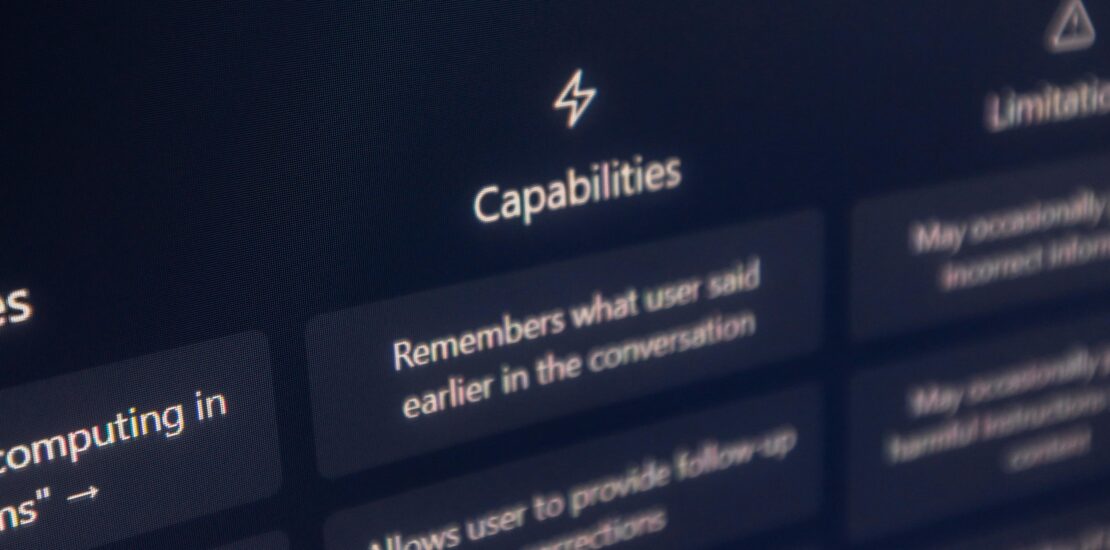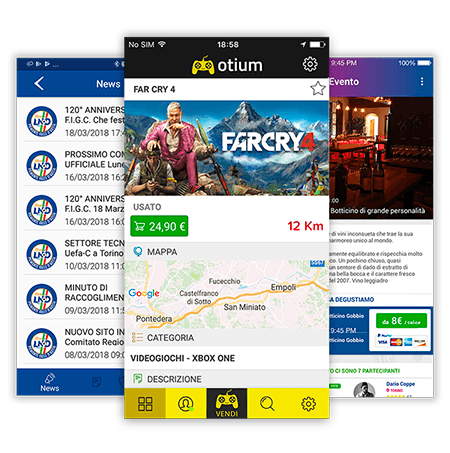- 11 April 2024
- Posted by: Maria Teresa Italiano
- Category: News

Intelligenza Artificiale e front-end development: tutto quello che devi sapere
Nell’era digitale in continua evoluzione, l’Intelligenza Artificiale (IA) emerge come una forza trainante di innovazione, trasformando radicalmente il modo in cui sviluppiamo e interagiamo con le applicazioni e i siti web. Nel cuore di questa rivoluzione si trova il front-end development, l’elemento visibile e tangibile di ogni esperienza digitale. Quello che un tempo sembrava fantascienza è diventato oggi realtà, con algoritmi intelligenti che semplificano e ottimizzano il processo di sviluppo del front-end in modi che prima erano impensabili.
Ma fino a che punto l’IA rivoluzionerà il front-end development, quale impatto avrà sul futuro delle interfacce utente, e soprattutto, sarà in grado di sostituire completamente il lavoro degli sviluppatori?
In questo articolo scopriremo insieme il ruolo chiave che l’IA sta giocando nella ridefinizione del front-end development e le implicazioni di questa trasformazione per gli sviluppatori e gli utenti. Esploreremo le nuove frontiere dell’automazione, della personalizzazione e della creazione di interfacce intuitive, gettando uno sguardo sul futuro e immaginando come l’IA plasmerà le nostre esperienze digitali nei prossimi anni.
5 principali utilizzi dell’IA nel front-end development
I primi utilizzi dell’Intelligenza Artificiale nel front-end development risalgono almeno a diversi anni fa, quando alcune aziende e sviluppatori hanno iniziato a sperimentare con algoritmi di machine learning e tecniche di IA per migliorare il processo di sviluppo e la user experience.
Vediamo insieme i 5 principali utilizzi che l’aziende hanno fatto dell’IA nel campo del front-end development.
Generazione automatica di layout e design
Nel front-end development, i primi utilizzi dell’IA hanno riguardato la generazione automatica di layout e design per le pagine web. Questi sistemi impiegano algoritmi di machine learning per analizzare modelli di design preesistenti e proporre automaticamente layout e stili per le pagine web.
Il processo di utilizzo dell’IA in questo contesto coinvolge diverse fasi:
Nel primo passaggio, è necessario raccogliere un vasto insieme di dati rappresentativi dei design esistenti. Questi dati includono informazioni sui layout, i colori, le tipografie, gli stili di navigazione e altri elementi di design presenti nelle pagine web reali.
Successivamente, si procede con l’addestramento del modello di IA utilizzando i dati raccolti. Attraverso l’uso di algoritmi di deep learning, come le reti neurali, il modello impara i pattern e le caratteristiche comuni nei design delle pagine web.
Una volta addestrato, il modello è in grado di generare automaticamente proposte di layout e design per nuove pagine web. Per farlo, riceve in input requisiti di design, obiettivi di progettazione e vincoli tecnici, producendo una vasta gamma di proposte che rispondono a tali criteri.
Le proposte di design generate possono quindi essere valutate da designer umani e sviluppatori, che ne verificano la qualità, la coerenza e l’aderenza agli obiettivi di design. Sulla base di questo feedback, il modello può essere migliorato e raffinato attraverso iterazioni successive.
Infine, una volta selezionato un design generato, viene implementato e personalizzato dagli sviluppatori per adattarsi alle specifiche esigenze del progetto. Questa fase comprende l’aggiunta di contenuti, la regolazione dei dettagli del layout e l’ottimizzazione per diverse dimensioni e dispositivi.
Prestazioni ottimizzate
L’Intelligenza Artificiale (IA) offre diverse possibilità per ottimizzare le prestazioni delle pagine web.
Innanzitutto, attraverso l’analisi delle risorse utilizzate, come immagini, script e stili CSS, gli algoritmi di machine learning individuano potenziali ottimizzazioni. Queste possono riguardare la compressione delle immagini o la riduzione del codice CSS non utilizzato, al fine di accelerare il caricamento delle pagine.
Inoltre, l’IA può essere impiegata per sviluppare sistemi di caching più sofisticati e dinamici. Questi prevedono le risorse richieste dagli utenti e le memorizzano in cache in anticipo, riducendo così i tempi di caricamento delle pagine.
Gli algoritmi di machine learning analizzano anche il codice sorgente delle pagine web per individuare eventuali problemi di prestazioni, come cicli di JavaScript inefficienti o blocchi di rendering che rallentano il caricamento. Di conseguenza, suggeriscono ottimizzazioni o correzioni per migliorare le prestazioni complessive del sito.
In aggiunta, l’IA ottimizza il processo di rendering delle pagine web, individuando e risolvendo problemi come ridondanze nei calcoli di layout o dipendenze delle risorse che rallentano il rendering. Ciò migliora la velocità di caricamento e la fluidità delle animazioni e delle transizioni sul sito.
Infine, gli algoritmi di machine learning analizzano le caratteristiche del dispositivo utilizzato dagli utenti, come la potenza di calcolo e la larghezza di banda di rete disponibile. In base a tali informazioni, adattano dinamicamente il caricamento delle risorse e il rendering delle pagine per massimizzare le prestazioni su quel dispositivo specifico.
Contenuti sempre più personalizzati
Alcune aziende hanno cominciato a sfruttare l’Intelligenza Artificiale anche per personalizzare dinamicamente l’esperienza utente, basandosi sul comportamento e sulle preferenze degli utenti. Per esempio, possono mostrare contenuti o offerte specifiche in base alle azioni pregresse dell’utente sul sito web.
Gli algoritmi di machine learning analizzano il comportamento passato dell’utente, come le pagine visitate, i prodotti acquistati o i contenuti preferiti, per creare raccomandazioni personalizzate. Queste possono includere prodotti correlati, articoli di blog simili o contenuti pertinenti in base agli interessi dell’utente.
Successivamente l’ IA sarà in grado di generare contenuti dinamici e personalizzati basandosi sulle preferenze dell’utente. Per esempio, un sito web di notizie può suggerire articoli rilevanti in base agli interessi dell’utente o alla sua cronologia di navigazione.
Ancora, gli algoritmi di machine learning possono prevedere le azioni future degli utenti e adattare le interazioni del sito web di conseguenza. Per esempio, un’app di e-commerce può anticipare gli articoli che un utente potrebbe voler acquistare e fornire suggerimenti pertinenti durante la navigazione.
Un ulteriore strumento molto apprezzato dalle aziende sono gli assistenti virtuali alimentati da IA, come i chatbot, i quali possono fornire assistenza personalizzata rispondendo alle domande degli utenti, guidandoli attraverso il sito web e offrendo supporto all’acquisto in base alle loro esigenze e preferenze.
Generazione di codice
Alcune aziende utilizzano l’IA per generare automaticamente il codice HTML, CSS e JavaScript per le pagine web, basandosi su design o specifiche fornite dagli sviluppatori. Questo può accelerare il processo di sviluppo e ridurre il tempo necessario per implementare nuove funzionalità o modificare il design del sito.
Ci sono diversi strumenti e risorse che utilizzano l’intelligenza artificiale (IA) per generare codice HTML, CSS e JavaScript per le pagine web…eccone alcuni che potrebbero esserti utili:
Copilot di GitHub: Copilot è un’assistente IA integrato nell’editor di codice Visual Studio Code, sviluppato da GitHub in collaborazione con OpenAI. Utilizza il modello GPT-3 per suggerire automaticamente codice HTML, CSS e JavaScript in base al contesto e alle esigenze del progetto.
UI Bakery: UI Bakery è un tool no-code che consente agli utenti di creare interfacce utente per le loro applicazioni web e mobili. Utilizza l’IA per generare codice HTML, CSS e JavaScript basato sul design visuale creato dall’utente.
Sketch2Code di Microsoft: Sketch2Code è un progetto di ricerca di Microsoft che utilizza l’IA per convertire i mockup grafici creati in Sketch in codice HTML. Gli utenti possono disegnare l’interfaccia utente desiderata su carta o utilizzare un’applicazione per disegnare digitalmente, e Sketch2Code si occupa di generare il codice HTML corrispondente.
Risoluzione tempestiva di errori e bug
Infine, l’IA è stata impiegata per rilevare automaticamente errori e bug nel codice front-end, agevolando gli sviluppatori nell’identificazione e risoluzione tempestiva dei problemi.
Ecco alcuni esempi pratici di come questo avviene:
L’IA può condurre un’analisi statica del codice sorgente delle pagine web per individuare eventuali errori di sintassi, vulnerabilità di sicurezza e altri problemi. Questo processo coinvolge l’identificazione di pattern sospetti o pratiche non conformi alle best practice di programmazione.
Può automatizzare il processo di testing delle pagine web, individuando rapidamente bug ed errori. Ad esempio, gli algoritmi di machine learning possono generare e condurre automaticamente test di regressione, individuando modifiche nel comportamento del sito web che potrebbero suggerire la presenza di bug.
L’IA è in grado di analizzare i log degli errori generati dalle pagine web in tempo reale per individuare pattern e tendenze indicative di problemi ricorrenti o emergenti, come errori di connessione al database o problemi di caricamento delle risorse.
Può individuare pattern di comportamento anomalo nelle pagine web, segnalando eventuali bug o vulnerabilità di sicurezza. Ad esempio, gli algoritmi di machine learning possono riconoscere tentativi di hacking o attacchi DDoS analizzando i modelli di traffico sulla pagina web.
Il vantaggio dell’ IA sta quindi nel generare automaticamente correzioni per i bug e gli errori identificati, riducendo al minimo il tempo necessario per intervenire manualmente. Ad esempio, può suggerire correzioni al codice sorgente o alle configurazioni del server che possono risolvere i problemi individuati.
L’ IA sostituirà completamente il lavoro degli sviluppatori?
Questi sono solo alcuni esempi dei primi utilizzi dell’Intelligenza Artificiale nel front-end development. Negli ultimi anni, il campo è cresciuto rapidamente con l’avanzamento della tecnologia e l’introduzione di nuovi strumenti e framework basati sull’IA. L’Intelligenza Artificiale (IA) ha il potenziale per automatizzare molte attività nel front-end development, semplificando il lavoro degli sviluppatori e consentendo loro di concentrarsi su compiti più complessi e creativi. Tuttavia, ci sono limiti alla capacità dell’IA di sostituire completamente il lavoro degli sviluppatori nel front-end development.
Una delle principali sfide è rappresentata dalla comprensione del contesto specifico di un progetto di sviluppo web. Nonostante l’IA sia in grado di generare codice funzionante, può avere difficoltà nel cogliere appieno le esigenze e le specifiche del progetto, rischiando di produrre soluzioni non completamente adatte.
Inoltre, l’IA potrebbe incontrare delle difficoltà nella produzione di soluzioni creative e originali. Sebbene possa generare codice che funziona correttamente, può essere meno efficace nell’ideare design innovativi e personalizzati, fondamentali per creare esperienze utente memorabili.
Un’altra sfida consiste nell’adattarsi rapidamente alle nuove tendenze e tecnologie emergenti nel settore del web development. L’IA è in grado di apprendere dai dati storici e dall’esperienza, ma potrebbe faticare a mantenere il passo con i rapidi cambiamenti del settore.
Pur offrendo molteplici vantaggi, l’IA nel front-end development delle pagine web presenta ancora dei limiti da superare. È quindi importante integrare l’IA in modo responsabile e complementare alle competenze umane, al fine di massimizzare i benefici e superare le sfide nel processo di sviluppo web.
In conclusione, affidati sempre a degli esperti del settore: gli sviluppatori web apportano un tocco umano e una comprensione approfondita delle esigenze del cliente che l’IA potrebbe non avere.
Il segreto per risultati sorprendenti? Combinare capacità umane con tecnologie IA!
Se vuoi applicare l’IA al tuo business prenota una call con Pizero, ti spiegheremo come integrare i migliori strumenti di IA all’interno della tua azienda, facendoti risparmiare tempo e denaro.


